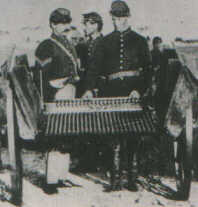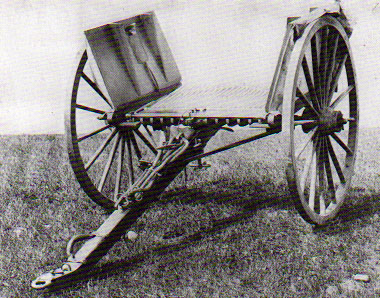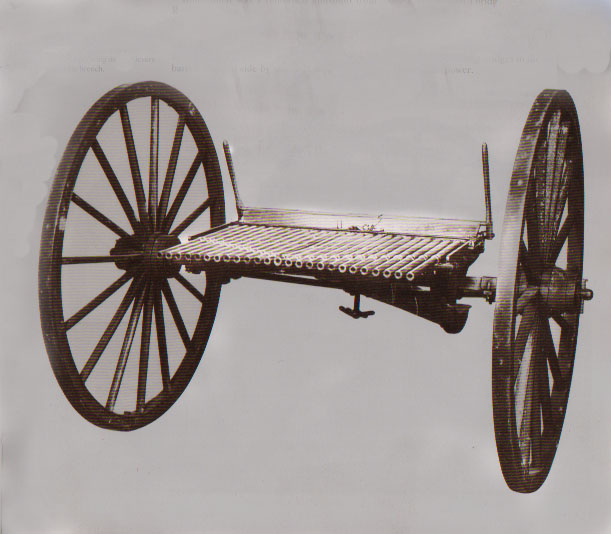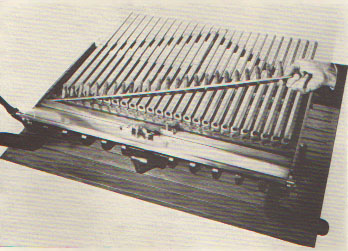Skip to comments.
'Metal Storm' weapons may replace Crusader
UPI Wire ^
| 5/12/2002 12:01 PM
| UPI Editor At Large
Posted on 05/12/2002 9:24:18 AM PDT by greydog
WASHINGTON, May 12 (UPI) -- EXCLUSIVE
A new ballistic technology that can fire burst rates in excess of one million rounds per minute from a 36-barrel weapon was one of the reasons Defense Secretary Donald Rumsfeld canceled the $11 billion Crusader artillery system.
The technology is known as "Metal Storm," which is also the name of the Australian research and development company that owns it.
The fastest weapons today are mechanical Gatling gun styles that can fire at the rate of some 6,000 rounds per minute. Infantry rifles average 600 rounds, which is the firing rate for a magazine of 15 to 30 rounds.
Admiral Bill Owens, a retired former deputy chairman of the Joint Chiefs of Staff and author of "Lifting the Fog of War," a controversial book about defense modernization, is the chairman of the board of Metal Storm Ltd. With multimillion-dollar contracts, Metal Storm works closely with the U.S. Defense Advanced Research Projects Agency and the Australian Defense Science and Technology Organization. Chuck Vehlow, a former general manager of the Boeing helicopter division, is the company's new chief corporate officer. Vehlow has negotiated big-ticket procurement contracts and technology licensing agreements with the Pentagon.
Most of Metal Storm's work is top secret. Already under development is an "area denial weapons system," including an unmanned aerial combat vehicle that will carry twelve 40-mm mortar boxes comprising a total of 1,200 tubes, and armed with 7,200 grenades. The system's unprecedented firing capabilities can lay down a continuous 50-meter-wide carpet of grenades for about two miles, firing all its grenades simultaneously with a five-yard separation on impact.
Another gun under development for a small combat aerial vehicle is multi-barreled and can fire 270 rounds onto a target in just .001 seconds without stress on the air frame or any drop in air speed.
The company's advanced individual combat weapon program is destined to replace small arms throughout the western alliance, said Mike O'Dwyer, company chief executive officer. The prototypes now being developed have a dual barrel capability to fire both 20-mm and 40-mm bursting munitions and standard 5.56-mm NATO ammunition.
The weapon will also fire "less-than-lethal" projectiles for riot control. The future infantry weapons hardware replacement program for Australia's small defense forces alone is estimated to be worth $700 million.
Metal Storm's submachine gun will be capable of firing multiple barrel rapid-fire bursts at 45,000 rounds per minute per barrel. The technology is 100 percent electronic. Its electronically variable rate of fire has been confirmed to one million rounds per minute.
The technology allows barrels to be grouped in any configuration required for a particular application because it has no moving parts, no separate magazine, no ammunition feed or ejection system. The only moving parts in this revolutionary ballistic technology are the bullets or other projectiles.
Next to "Metal Storm's" firepower, said a senior Pentagon acquisition official, the lumbering, 45-ton Crusader artillery tube would be obsolete equipment.
At the core of the new technology is a projectile design that allows multiple high-pressure ammo to be stacked in-line in a barrel, then electronically fired in sequence. In turn, multiple barrels can be grouped together to form compact weapons systems of unprecedented conventional firepower. These new weapons will have all-electronic access control systems to ensure that only authorized personnel use them. The dual function will also allow on-board selection at the press of a button between a non-lethal response capability and the kind of lethality that will deny an area to the enemy without having to use anti-personnel landmines.
Metal Storm also makes the Vle, a handgun with a 64-digit electronic keying system that conceals a transponder. An electronic message confirms when the weapon is set to fire and which fire setting is selected.
U.S. defense sources said the Metal Storm technological breakthrough will produce a new generation of weapons that will "accelerate out-of-atmosphere ballistic missile interdiction as well as biological and chemical cloud neutralization."
The technology is not just used for firing projectiles. It is an electronically controlled delivery system that has potential applications in fire fighting, fireworks displays, aerial advertising in the night sky, precision chemical distribution in agriculture, and seismic surveying for minerals and oil.
Copyright © 2002 United Press International
TOPICS: Business/Economy; Foreign Affairs
KEYWORDS: crusader; metalstorm; miltech; superweapons
Navigation: use the links below to view more comments.
first previous 1-20, 21-40, 41-60, 61-74 last
To: archy
 A BILLINGHURST-REQUA BATTERY AS IT APPEARED IN AN EARLY FIELD TEST
A BILLINGHURST-REQUA BATTERY AS IT APPEARED IN AN EARLY FIELD TEST Although the Gatling Gun, patented Nov. 4, 1862, proved to be a superior weapon, the Billinghurst-Requa battery , patented Sept. 16, 1862, predates the Gatling and for this reason has been referred to as the first "practical" machine gun to be used during the war. The multiple barrel design was first suggested in the Renaissance, but it was the invention of the self-contained metal cartridge that made the idea practical. Only three gunners were needed to service the Requa volley gun. The cleverly arranged breech which closed on a piano hinge allowed for the ammunition strips to be loaded, fired, extracted, and reloaded quickly.

Rear View of the Volley Gun with the Protecing Barrel Covers Open and the Breech Mechanism Closed
There are records of the Federals using volley guns at the siege of Charleston, SC in 1863. Elements of the 39th Illinois Infantry, the 3rd New Hampshire Artillery, and the 48th New York Volunteer Infantry used Requa batteries in the attack on Fort Wagner. They trained their volley guns on the Confederate works in support of an infantry attack.

Front View of the Requa Battery on Exhibit at the Kentucky State Museum
The Federal army may have had as many as one hundred volley guns, but most were placed in the defenses around Washington, DC. The Confederate government purchased at least twenty volley guns prior to the opening of hostilities and may have purchased more thereafter. Incomplete southern records have obscured any exact record of their number or deployment.

A Better View of the Dismounted Breech with Cartridge Strip
When the side mounted loading levers were up (as in this picture) the breech was open. A powder train was laid behind the ammunition strip. Pushing the levers forward secured the breech. A musket cap was placed on the centrally located priming nipple and activated with a simple flip-over hammer mechanism.The barrels, each 24 inches long, fired sequentially from the center out with a characteristic rippling effect. Note the elevating screw below the breech mechanism.
A Better View of the Dismounted Breech with Cartridge Strip Requa batteries were sometimes called "Covered Bridge Guns" because they could command the length and width of a bridge. This probably ancedotal nickname belies the purpose of the weapon which was to be deployed in the field in support of infantry regiments. Although designs for more barrels existed, Volley guns with 25 rifle barrels set in parallel were most common. The weapon could be fired at the rate of seven strips per minute by a trained crew. This gave a rate of fire of 175 rounds per minute. The strips were pre-loaded and carried in an ammunition case on a limber. The limber could be pulled by as few as two horses.
61
posted on
05/12/2002 1:30:18 PM PDT
by
archy
To: archy
Think of it as a box of Roman candles, set off electrically with an electronic switching setup. Even an old plough jockey could rig something along those basic lines up- the real trick will be in the materials and projectile design.
This plough jockey is concerned about the obvious problem of reloading and also the higher potential for a premature misfire from a projectile further down in the order. In such an event, the chain reaction would be devastating to our boys. Raw rate of fire, can have impressive numbers but, its not the be-all and end-all, imo. I realize no one is claiming it is.
62
posted on
05/12/2002 1:34:05 PM PDT
by
pyx
To: HardStarboard
There is no "back blast". Go to the video at the Metal Storm site (see post #23) and see for yourself. You may not want to throw rocks at this technology after you educate yourself as to what it is. I was present at the live fire demonstration to the US Navy Fleet Logistics Support Command at one of the Naval Surface Warfare Centers a couple of years back.
I'm not throwing rocks at the possible future applications of the technology, but neither multibarrel launchers nor linear propellant/projectile stacking within those barrels is a *new technology.* And I an quite aware of what it is.
But you might want to be more aware of where it can be heading.... and the marriage of the Burney recoilless principle with the Metalstorm electronic sequencing of ignition offers some near-term practical applications.
-archy-/-
63
posted on
05/12/2002 1:36:49 PM PDT
by
archy
To: pyx
This plough jockey is concerned about the obvious problem of reloading and also the higher potential for a premature misfire from a projectile further down in the order. In such an event, the chain reaction would be devastating to our boys. Raw rate of fire, can have impressive numbers but, its not the be-all and end-all, imo. I realize no one is claiming it is. Don't bother with reloading it. Better, VERY carefully engineer the launch tubes to be as minimalist and lightweight as possible for one-time use, and once fired, use it as a doorstop, and hook the sequencing control and possible sighting equipment up to the next preloaded package, just as is done with the disposable tube of a LAW antitank weapon or just as the tracker and firing units of the Stinger MANPADS ground-to-air missile or Dragon antitank missile launcghers are attatched to preloaded launch units. That allows them to be lighter, since they're to be used but once, and if made of non-strategic materials such as advanced plastics/polymers, composites or ceramics, can be easily disposable- and troops in the field will always find uses for the leavings.
Chainfires are an obvious potential problem. One way of overcoming that problem is if every tenth, or fifth, or third *projectile* rather than being the usual slug or shell, is instead filled with a liquid bore cleaner and coolant. In something the size of a 40mm grenade launcher, that might not be a problem, with only a few rounds per short tube, probably 10-12 or so. But in the fixed multitube units, that might be more of a concern, just as it was during the Civil War when improper operator input resulted in *stacks* of bullets and powder charges in the rifles of that day as scared troops forgot to discharge their weapons while repeatedly reloading- and then would touch one off, sometimes with lethal results on both ends.
-archy-/-
64
posted on
05/12/2002 1:49:52 PM PDT
by
archy
To: archy
>>>
and the marriage of the Burney recoilless principle with the Metalstorm electronic sequencing of ignition offers some near-term practical applications. <<< Then we agree - many here are treating this as the stuff of science fiction (or mindless fools). But then the Warthog's Gatling and the Phalanx were science fiction until after WWII.
One point that I didn't make previously - I'm a fan of Rumsfeld and his management style. I doubt that he would sacrfice the Crusader if he didn't have something in mind - maybe not to be operational next month - but in plenty of time to make an $11 billion investment in the Crusader look like money down a rathole.
I think Rummy's point is that we don't need the Crusader now...what we got is plenty good for say 3 to 5 years. By then - the new technology will be matured and operational.
Smart guy in my book!
To: HardStarboard
Suggest you got to post #23 and view the video at the Metal Storm site. Pretty damn impressive if you ask me! you may not want to throw too many rocks at the concept! I have looked at the site and they really dont explain enough. If they have a way of reloading the weapon without changing the barrel or having to reload bullet by bullet that would be good. I'm not saying I dont like the idea of this technology but as they've described it I dont see how it could replace artillery or even smg's or pistols.
Does anyone know how they load the bullets into the barrels in the first place?
66
posted on
05/12/2002 3:29:25 PM PDT
by
PuNcH
To: PuNcH
>>>
Does anyone know how they load the bullets into the barrels in the first place?<<< My impression is that you load a "rack of barrels" at a time. A stack of them perhaps 6 or 8 tall - all with rounds preloaded. I also beleive that these barrels are not the treated and forged steel barrels of current weapons. since each round carries its own propellant/charge, they are more like mini-rocket tubes, and thus can be made much lighter than steel barrels of your standard machine gun - or field gun for that matter.
Perhaps you didn't get a chance to look at the video - its under Technical Demonstration. Takes 9 minutes (streaming video)and explains much of the technology.
To: archy
I heartily disagree with your suppositions.
68
posted on
05/12/2002 6:44:42 PM PDT
by
RLK
To: in the Arena
Click on the link on post#22, then click the tab marked Videos. Watch the entire thing, it's amazing.
To: RLK
I heartily disagree with your suppositions. No problem. The metalstorm experiments are in an early enough stage that they might develop in any of a number of ways, either one of those noted by either of us, or in others yet unforseen, as other materials and design possibilities are considered. Disagreement is welcomed, for from such considerations of the full spectrum of facts come the necessary compromises which design engineers have to face and deal with.
That too will have to be balanced against other related developments; the OICW program, for instance, which the Metalstorm technologies might either compete against or mesh with; we shall see.
But as for the Navy's consideration of discs in flight, ranging from frisbees to clay pigeons to illumination flares, that is not supposition: I was an ordnance employee with FLSD NavWepSupCom at the time and I was there. And the ring airfoil grenades are also an existing, proven technology, though not greatly advanced beyond the prototype stage, so far as I know. Both are certainly more fully developed than Metalstorm, which despite their swell public relations capabilities, are certainly not yet capable of being fielded as practical tools. Whether Metalstorm can also overcome the notorious NIH factor in American weaponry and equipmebnt development and procurement remains to be seen as well.
-archy-/-
70
posted on
05/13/2002 9:00:06 AM PDT
by
archy
To: Double Tap
You are correct and I was wrong.
To: greydog
I read about this "metalstorm" in a the April (or March) issue of Soldier of Fortune.
I think it uses multiple rounds lined up one after another in each barrel of the weapon and (if I remember correctly) it uses and electronic ignition system to fire the rounds, the first round firing seals itself against round behind it.
I'll try and find the article and post more data on this later.
To: Fishing-guy
Most of Metal Storm's work is top secret. Already under development is an "area denial weapons system," including an unmanned aerial combat vehicle that will carry twelve 40-mm mortar boxes comprising a total of 1,200 tubes, and armed with 7,200 grenades. The system's unprecedented firing capabilities can lay down a continuous 50-meter-wide carpet of grenades for about two miles, firing all its grenades simultaneously with a five-yard separation on impact. Sounds like artilery to me. It may not have really large shells but, I wouldn't want to be in that 50-meter wide, two mile long corridor when they arrived. Sounds like a new way of delivering cluster munitions. Could be very effective.
To: Reaganesque
Plus, if you can fire ten thousand of these smaller rounds in the same period of time that it takes the Crusader to fire a half a dozen shells, what's the difference? You're talking a wall of metal coming at you instead of a handful of high explosive rounds. Same effect/result really.
Also, the website compares the operation of Metal Storm to an inkjet printer head. An inkjet printer head heats up small droplets of ink and fires them onto the page. When you run out of ink, you replace the cartridge. Similar concept with Metal Storm. You load it with cartridges of barrels that are preloaded with ammunition and charges. Multiple cartridges with different types of munitions can be loaded all at the same time. When you run out, you replace the cartridges with new ones. Add to that computer controlled electronic fire control, and you have a weapon that can literally "print" an area with multiple types of munitions in whatever pattern is needed.
One of the videos shows a couple of Apache helicopters calling in a couple of UCAVs equipped with this system. The UCAVs, programmed with information gathered by the Apaches, pass over the target areas and, like a printer head, drop bombs in a predetermined pattern. They could actually bomb an area and leave a smoking smiley face on the ground. Heck, instead of scrawling messages on bombs as has been done in previous wars, we could literally scrawl messages with bombs. If it works as advertised, such fire control with such massive amounts of ordinance would in fact be revolutionary.
Navigation: use the links below to view more comments.
first previous 1-20, 21-40, 41-60, 61-74 last
Disclaimer:
Opinions posted on Free Republic are those of the individual
posters and do not necessarily represent the opinion of Free Republic or its
management. All materials posted herein are protected by copyright law and the
exemption for fair use of copyrighted works.
FreeRepublic.com is powered by software copyright 2000-2008 John Robinson
 A BILLINGHURST-REQUA BATTERY AS IT APPEARED IN AN EARLY FIELD TEST
A BILLINGHURST-REQUA BATTERY AS IT APPEARED IN AN EARLY FIELD TEST

